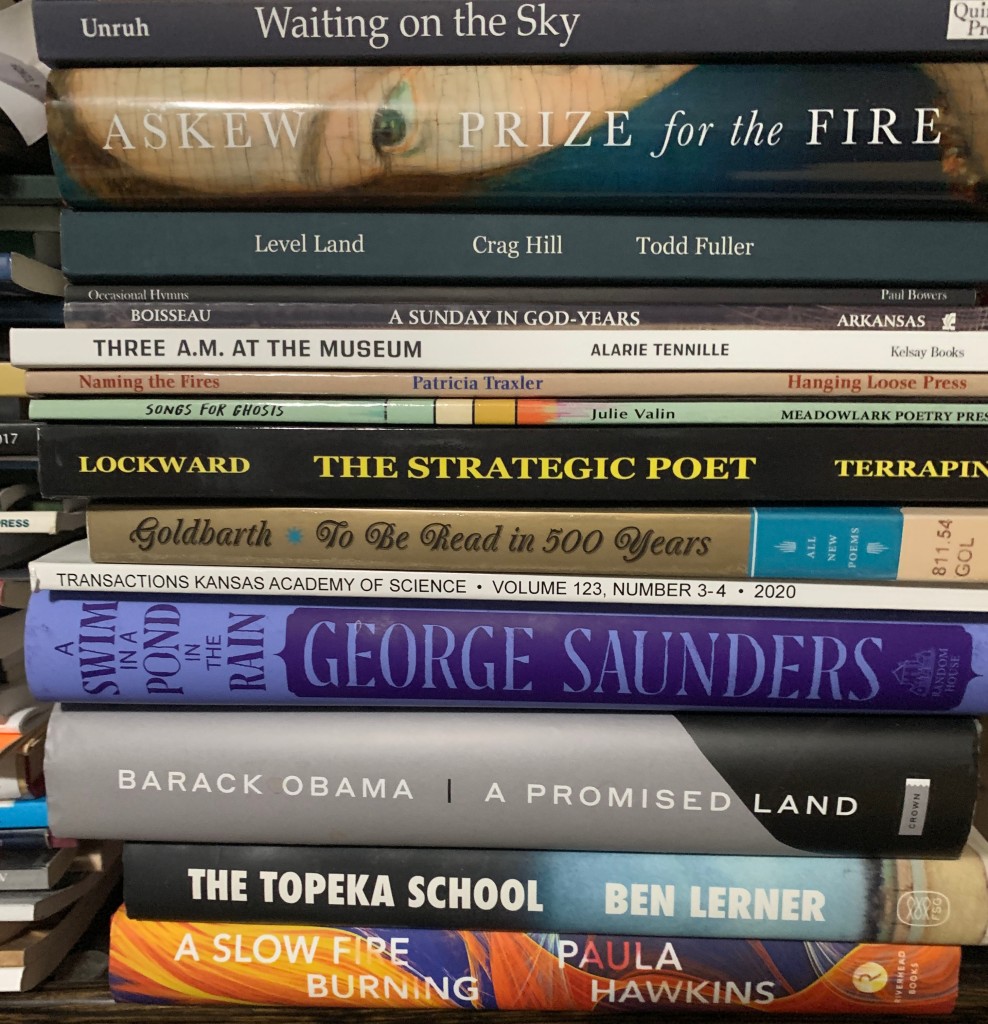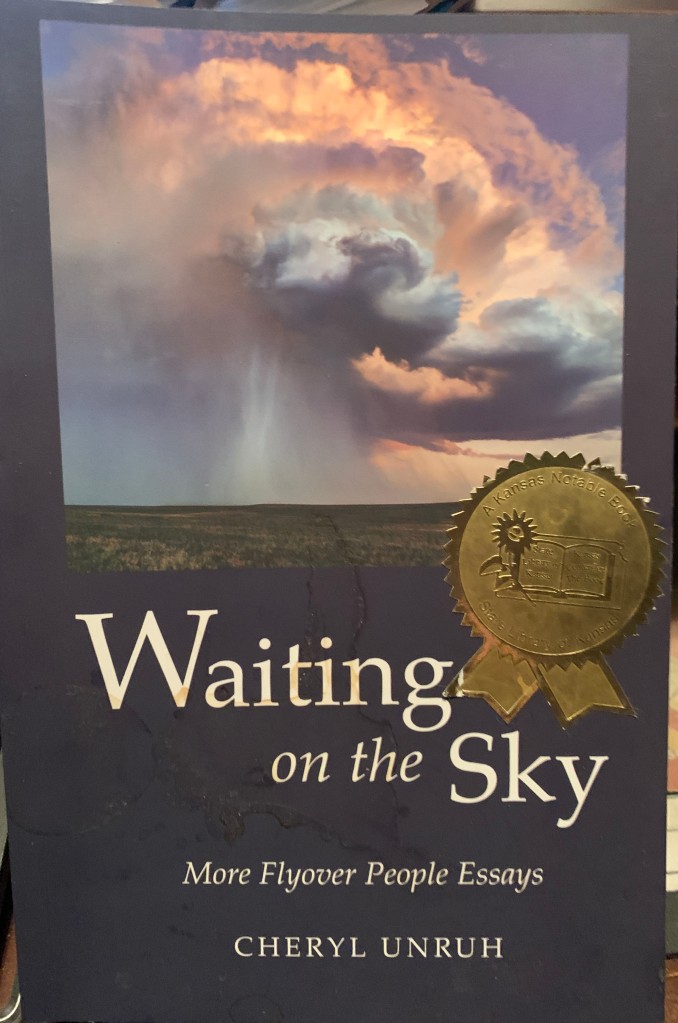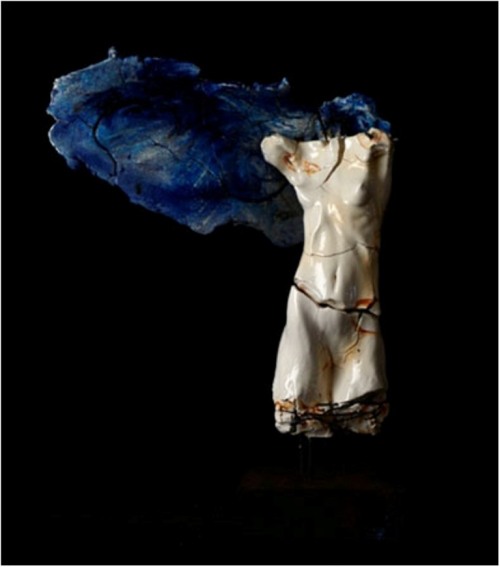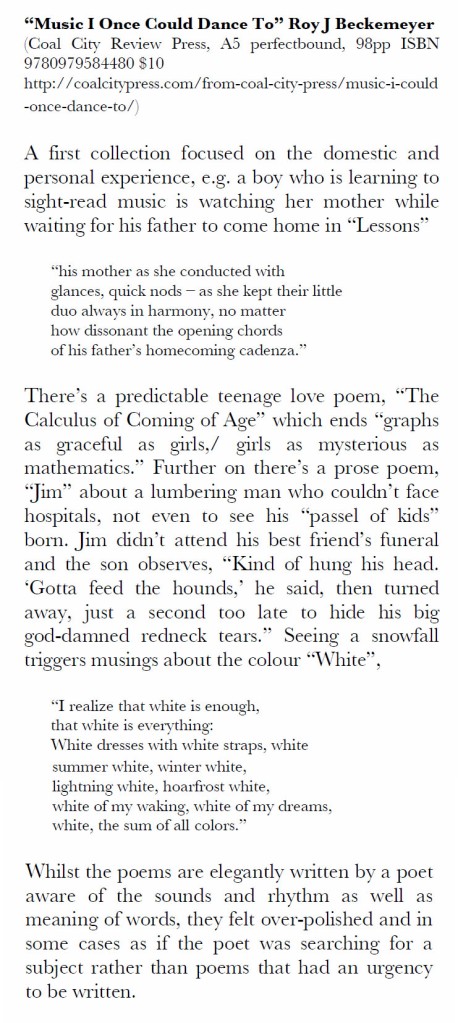A Stack of Books – Part 1

Here’s a stack of books – one small stack amidst bookcase after bookcase, stack after stack of books. These are in this stack because I have been into them, reading or rereading, browsing or devouring. Some are old friends, others unopened until now. I thought I would take this picture, then take up each book in hand and excerpt some snippets that I particularly like to share with you. Who knows, perhaps you will get interested, search for the book in your local library or online or in your favorite bookstore, pick up a copy, get infatuated with the author’s style or substance, maybe even go on a treasure hunt for more of their work. Stranger things have undoubtedly happened.
So here goes. Let’s begin with the top of the stack. Waiting on the Sky: More Flyover People Essays (Quincy Press, 2014), by Cheryl Unruh of Emporia, Kansas, is a book I bought from Cheryl herself at the 2015 Kansas Book Festival. It had won a 2015 Notable Book Award, as had my first book of poetry. I was familiar with Cheryl’s writing as I had read her first book, Flyover People: Life on the Ground ina Rectangular State (Quincy Press, 2011), which had also been a Kansas Notable Book awardee. Both books were based on weekly columns, titled (you might have guessed) “Flyover People,” that had appeared in The Emporia Gazette (yes, that famed newspaper).

Both of these books celebrate Kansas and the prairie and their denizens in fine style. I’ll let her speak for herself. If you’ve never experienced life on the prairie, she’ll give you a feel for why you would be hard pressed to find a way to wrench many of us from this big-sky country. But here, I’ll give Cheryl the floor:
From “Positives and Negatives” (January 2009):
“While other states are cluttered with forests or mountains or major metropolitan areas, we are blessed with a Zen-like landscape, the prairie.
…Yes less is more. We value our negative space.
In art, negative space is that part of a photograph or painting that is not the center of attention. Negative space is silence, background, an empty place where your eyes can rest. You may feel peaceful while gazing toward a grassy pasture, or you can rest your eyes upon the sky, that claming blue presence with its free-range clouds.
Here, we have the Flint Hills, a restful place for the soul, an open sanctuary in which the sky is our prayer book, the wind our hymnal.
After dark, we step into a cave of stars. In the big ol’ night sky, we draw our own constellations. We connect the dots, creating a Native American warrior or maybe a fearsome John Brown.
With our heads leaned back, we can count white lights till we’re dizzy. Out on the grassland we can almost hear the twinkling of those stars.”
From “At Home in the Flint Hills” (November, 2013):
“It’s quiet on the prairie, but not always silent. Insects and birds chatter. Some days there’s a growl of wind as gusts sweep the prairie without regard for man or beast. Wind can spin like a dervish, or it can ride low and slow and straight over the grasses, playing them like flutes.
A herd of bison lives on the preserve. Bulky and brown, they stand still like paperweights, holding down the prairie on those windy days.
The treeless landscape is one hill folding into another, bodies of hills lying together. We make our own shadows here, unless a cloud runs interference with the sun.
As a hawk glides overhead, we feel the rhythms of land and sky. Here, we step into that space between questions and answers, a place where we are satisfied with the unknown.
After dark the wind settles down, and the Milky Way flings itself across the sky. A rumor of coyotes hangs in the night air.”
From “Sunset Alert” (November, 2010):
“My friend Janet Fish, of Madison, paid close attention to sunsets when she and her husband, Larry, lived in Emporia. She said, ‘There were late afternoons when Larry would zip in and holler sunset alert and we’d stand in the yard and watch with our arms around each other.’
Janet said that from their location the color in the sky would glow behind the steeple of Sacred Heart Church. ‘Some nights it was so stunning that it would bring tears to our eyes.’
Janet has suggested a neighborhood notification system, church bells perhaps, something that would get our attention and send us all out into our yards to take in the show.
…
Our lives would be richer, wouldn’t they, if we each spent one minute a day watching the sky fill with flaming color. I can picture it now in every Kansas town: yards, sidewalks and driveways filling with neighbors, heads raised, eyes to the western sky, absorbing that moment of splendor. Let’s do it. I’ll meet you outside tonight.”
______________________
Okay, there you have an appetizer of Cheryl’s way with words. No full meal for you today. Rather, look for a copy of your own, and then you can nibble or pig out to your heart’s delight.
And watch for the next entry in this sampling of writing from my stack of books.
______________________
~Roy Beckemeyer, September 22, 2023.





